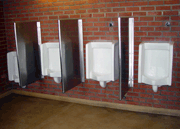Small Changes Make a Big Difference

Caption plum:Urinals use less water than toilets
Common indoor fixtures and appliances include toilets, urinals, faucets and showerheads. Considerable water savings can be achieved by upgrading and modifying these technologies. In many cases, fixes are small and cheap. For example, aerators for faucets cost as little as $2 each and washers that prevent leaks cost pennies. Industry-specifc upgrades can also make a big dent on your water use.
Toilets
Consider replacing inefficient toilets (often using more than 3.5 gallons per flush) with high-efficiency ones that use less than 1.6 gallons per flush. Dual flush toilets use even less water when removing liquid waste. If replacing toilets is not an option, existing toilet tanks can be retrofit with displacement devices to reduce per-flush use. (Use non-potable water sources for toilets and urinals as an additional water-saver).
Urinals
For good return on investment, replace urinals with models that use no more than one gallon per flush (low-flow, ultra low-flow and waterless urinals are available). Replacing one conventional urinal with a waterless model could save as much as 45,000 gallons in one year.
As urinals generally use less water than toilets, always provide urinals in men's restrooms to reduce water consumption. Even a small business with a single-toilet men's room can achieve savings by adding a urinal.
Faucets
Install automatic low-flow faucets with quick shut-off settings (either infrared or spring models) - water use by taps can reduce by 50 percent. Make sure older faucets are fit with aerators.
Showerheads
Low-flow shower heads can cost under $10, yet pay for themselves in the first year. For hotels and other establishments with many showers, payback time is short and long-term cost benefits are large. The most water-efficient units will use no more than 1.5 gallons per minute.
Heating and cooling
Once-through cooling systems that use a continuous flow of water are wasteful. By replacing your once-through cooling with an air-cooled system or cooling towers, you can potentially eliminate all cooling-related water use. Your cooling towers should be equipped with overflow sensors and achieve at least five cycles of concentration.
For boilers, reuse steam condensate when possible and install leak-detection devices (such as makeup meters). Consult a Valley heating and cooling professional for customized upgrades.
Where can I find out more?
